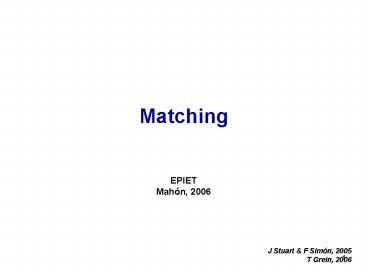Matching - PowerPoint PPT Presentation
1 / 27
Title: Matching
1
Matching
EPIET Mahón, 2006
J Stuart F Simón, 2005T Grein, 2006
2
Once again confounding
Exposure
Outcome
Third variable
Be associated with exposure - without
being consequence of exposure
Be associated with outcome -
independent of exposure
3
Control of confounders
- In analysis
- Stratification
- Multivariable analysis
- In study design
- Randomization (experiment)
- Restriction
- Matching
4
Matching
- Ensures that confounding factor is equally
distributed among each of study groups - Controls selected to match specific
characteristics of cases - Unexposed selected to match specific
characteristics of exposed - Achieves balanced data set that can
- Prevent confounding (if matched on confounder)
- Increase study precision
- Focus on case-control studies as implications
more important
5
Types of matching
- Individual matching
- Controls selected individually for each case by
matching variable - Pairs of individuals (11)
- Selection of more than one control per case (1n)
- Frequency matching
- Number of controls selected according to number
of cases in categories of matching variable - Matching done by groups of subjects
- In both cases, analysis must take matching design
into account
6
Individual matching
- Echovirus meningitis outbreak, Germany, 2001
- Is swimming in pond A risk factor?
- Case control study with each case matched to one
control
Source A Hauri, RKI Berlin
7
Individual matching
- Echovirus meningitis outbreak, Germany, 2001
- Is swimming in pond A risk factor?
- Case control study with each case matched to one
control
Concordant pairs
Source A Hauri, RKI Berlin
8
Individual matching
Matched 2x2 table
Unmatched 2x2 table
x
9
Individual matching Analysis
- Treat each pair as one stratum
- Calculate Mantel-Haenszel odds ratio
- Nomenclature matched 2x2 table
10
Individual matching Analysis
11
Individual matching Analysis
12
Individual matching Analysis
13
Individual matching Analysis
14
Individual matching Analysis
15
Individual matching Analysis
16
Matching case to n controls
- Same principle as 11 matching
- Constitute pairs
- Pair (1 case, 1 control)
- Triplet (1 case, 2 controls) yields 2 pairs
- Quadruplet (1 case, 3 controls) yields 3 pairs
- Etc
- Stratified analysis by pairs
17
Matching case to n controls
18
Frequency matching Analysis
19
Frequency matching Analysis
Stratum 3Stratum 4
20
Frequency matching Analysis
- With many strata, stratification quickly leads to
sparse data problem - Matching for gt 1 confounder
- Numerous nominal categories
- Conditional logistic regression
- Logistic regression for matched data
- Conditional on using discordant pairs only
- Matching variable itself cannot be analysed
- Testing for interaction of matching variable
possible
21
Why stratified analysis?
- Matching eliminates the original confounding, but
introduces another confounding factor - Controls no longer representative of source
population as selected according to matching
criteria (selection bias) - Cases and controls more alike. By breaking match,
OR usually underestimated - Matched design matched analysis
22
Overmatching
- 20 cases of cryptosporidiosis
- ? associated with attendance at local swimming
pool - Two matched studies
- Controls from same general practice and nearest
date of birth - Cases nominated controls (friend controls)
23
Overmatching
GP, age-matched OR f/g 15/1 15
24
Advantages of matching
- Useful method in case-control studies to optimise
resources - Can control for complex environmental, genetic,
other factors - Siblings, neighbourhood, SES, utilization of
health care - Can increase study efficiency
- Overcomes sparse-data problem by balancing strata
- Maximises information when sample size small
- Sometimes easier to identify controls
- Random sample may not be possible
25
Disadvantages of matching
- Cannot examine risks associated with matching
variable - If no controls identified, lose case data, and
vice versa - Overmatching on exposure will bias OR towards 1
- Complicates statistical analysis
- Residual confounding by poor definition of strata
- Sometimes difficult to identify appropriate
controls
26
Take-home messages
- Useful technique if employed wisely
- Balanced data sets, increased precision,
prevention of confounding - Can control for complex factors which would be
difficult to measure otherwise - Do not match because it is convenient
- Routine
- Tedious to obtain random sample from source
population - Want to avoid large sample size
- If you match, make sure you match on a confounder
27
Thank you































